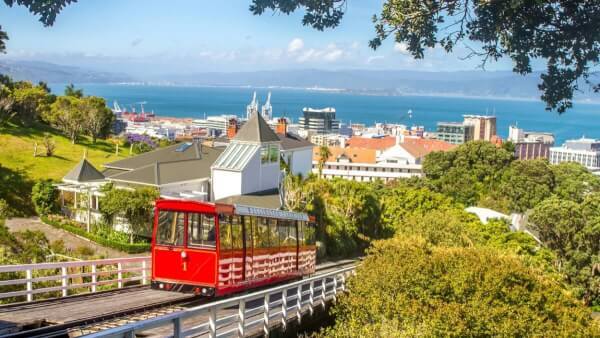Best Time to Visit New Zealand from Australia: What to do, weather, visas, and more
Wondering when the best time to visit New Zealand from Australia is? Learn more about weather, seasons and what to do throughout the year in New Zealand.

Whether you’re heading to New Zealand on a once-in-a-lifetime holiday or to set up your new home, you’ll need to find out how money works in the country. Here’s what you should be aware of when it comes to New Zealand ATMs.
There are almost 70 ATMs in New Zealand for every 100,000 adults, according to the World Bank’s most recent figures - comfortably above the world average of around 50. So if you’re in a city or major town, you shouldn’t ever be too far away from one: look for them at local bank branches, shopping centres and in certain shops.
Even better, plan ahead and consult an ATM locator. New Zealand’s 4 largest banks have ATM locator tools, which you can find here:
Relatively few banks from outside New Zealand and Australia have branches in New Zealand. Here are a couple of them and how to find their ATMs.
New Zealand is well equipped when it comes to card payments, which means you shouldn’t have a problem if your card is from one of the major networks. While details might vary between countries and particular accounts, your card is likely to work whether it’s from the US or Australia or Europe or anywhere else.
If you have a foreign credit or debit card, check what network it’s on and use one of these locators to find an ATM one near you.
New Zealand PINs are generally 4 digits long. If you have a 6-digit PIN, you might find New Zealand ATMs that accept all 6 digits with no problems, but to be sure about this it’s worth talking to your bank. It might be worth seeing if you can change your PIN to 4 digits - not a bad idea if you travel a lot because 4 digits is more common overall around the world.
If you want to pay for something directly by card, the most common methods in New Zealand are ‘chip and PIN’, where you put in your PIN when you make the purchase, or ‘contactless’ for small or medium purchases, where you just touch your card to a card reader. Swiping or signing for purchases is less common now. So if your card is set up for chip and PIN or contactless, your time in New Zealand might be a little easier.
With a number of New Zealand banks, in addition to a normal limit of $2000 max withdrawal per transaction, to cut down on fraud, there are limits on how much cash you can take out of ATMs each day. For instance, Westpac has a daily limit of $3,000 for domestic withdrawals, and ANZ has a daily limit of $2,000.
That’s the New Zealand banks, though. Your own international bank might set its own limit on how much cash you can take out each day when you’re abroad. So before you travel to New Zealand, check with your bank to see how much cash you’ll be able to withdraw.
It’s always a good idea to notify your bank if you’re travelling abroad. That way, when you use your card abroad, they won’t assume it’s been stolen and accidentally block it.
Whenever you use an ATM, you should keep alert in case it charges you for the privilege. Here’s a look at the various different fees you need to know about.
If you withdraw money from a foreign bank account at an ATM, the ATM might ask you which currency you want to be charged in or view the transaction in - New Zealand dollars, or your home currency.
If you get an option to do the transaction in your home currency, called Dynamic Currency Conversion (DCC), it’s always best to refuse this service. If you fall for the option, instead of your home bank choosing an exchange rate, the machine will calculate its own exchange rate. The exchange rates given to you by foreign ATMs are notoriously bad. Foreign banks don’t care about keeping you as a customer because you don’t bank with them. So the rates they set are usually very poor for the customer - with some reports that ATMs take an extra 18% in the exchange rate markup.
If you choose to be charged in NZ dollars, the exchange rate on offer will be better, meaning that you’ll be charged less for the same amount. The exchange rate might still not be as good as the mid-market rate, but it’ll be a lot better than with DCC.
Many of the charges you’ll face at a New Zealand ATM won’t be from New Zealand banks. Your home bank may well charge you every time you use your card abroad, even if it’s just to withdraw cash.
Before you travel to New Zealand, check what you’ll be charged by your home bank for each ATM withdrawal abroad. They may take a percentage of the amount as well as a flat fee.
If you have a New Zealand bank account, then your bank might charge you if you use another New Zealand bank’s ATM rather than one of theirs. However, charges are less common from the ATM-owning bank itself. The same principle is true if you’re using a foreign card in New Zealand: as explained above, you’re more likely to be charged by your home bank than by the New Zealand bank where you withdraw your money. There may be exceptions, however.
Free is a bit of a stretch, but it’s definitely worth finding out if your home bank has any partnerships with New Zealand banks. For instance, Westpac is part of the Global ATM Alliance, which means that if you bank with Barclays, Bank of America, Deutsche Bank, Consorsbank, or BNP Paribas, then depending on your card or account type, you may be able to use a Westpac ATM in New Zealand without having to pay certain fees charged by your home bank. Other such partnerships exist as well - check with your home bank to see if they have a partner in New Zealand.
The withdrawals still probably aren’t free, though: often you’ll still have to pay some fees, and unless you’re charged the mid-market rate, you’ll be losing out via the exchange rate as well.
ATM fees are universally unpopular, but there are sometimes ways out - of some of them, at least. Here are a few ideas you can try.
It’s tough to find a good exchange rate if you use a bank because they can convert your money at the rate they choose themselves. But Wise always uses the only exchange rate that’s fair for you: the mid-market rate. So if you’re sending money into New Zealand, Wise usually works out a lot cheaper than a bank.
ATMs look convenient, but - as so often when banks are involved - there can be any number of hidden charges. Take care when using New Zealand ATMs, and good luck.
This publication is provided for general information purposes only and is not intended to cover every aspect of the topics with which it deals. It is not intended to amount to advice on which you should rely. You must obtain professional or specialist advice before taking, or refraining from, any action on the basis of the content in this publication. The information in this publication does not constitute legal, tax or other professional advice from TransferWise Limited or its affiliates. Prior results do not guarantee a similar outcome. We make no representations, warranties or guarantees, whether express or implied, that the content in the publication is accurate, complete or up to date.
*Please see terms of use and product availability for your region or visit Wise fees and pricing for the most up to date pricing and fee information.
This publication is provided for general information purposes and does not constitute legal, tax or other professional advice from Wise Payments Limited or its subsidiaries and its affiliates, and it is not intended as a substitute for obtaining advice from a financial advisor or any other professional.
We make no representations, warranties or guarantees, whether expressed or implied, that the content in the publication is accurate, complete or up to date.

Wondering when the best time to visit New Zealand from Australia is? Learn more about weather, seasons and what to do throughout the year in New Zealand.

Find the best travel insurance for your New Zealand trip. Compare Australian providers' coverage, prices, and benefits.

Travelling from Australia to New Zealand? Let’s fill you in on the travel requirements, touristy and non-touristy spots and other need to knows in our guide

While credit and debit card payments are incredibly popular in New Zealand (almost more so than they're in Europe), it’s still a good idea to have some cash...